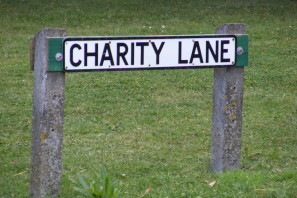Ours is a large co-educational Secondary school. Most of our students are white and come from affluent families. The school’s size was seen as a limiting factor in trying to develop Global Citizenship across the entire curriculum given the timescale. I decided to focus initially on one year group and build upon this as they move through the school. The unit of work will be repeated for the younger year groups when they begin Year 9 (age 13 to 14).
Using RISC’s resource Are We Nearly There? a self evaluation framework for Global Citizenship I defined the areas that needed most work:
- Curriculum Planning. As a Geography teacher I was able to identify areas in our department where Global Citizenship was covered. We deliver a Development scheme of work. In this we cover Fairtrade, global inequalities and development indicators. The trade simulations games are a very popular aspect of this scheme of work as is the topic of sweatshops and the impact of cheap fashions e.g. Primark. The idea of Global Citizenship does get covered in other subject areas such as Science (eg Ecological Footprints) and English (eg Climate Change and our role in this). However, this is not audited by the school and the link to the actual concept is not made explicit. It is not a priority in assemblies and only touched upon occasionally.
- Under the Charitable activities I ranked the school as 1 (inadequate). Students raise money for a number of different causes through two charity days. These are entitled Carnival for Charity in Year 9 (as part of the PSHE/Citizenship course) and Giving Something Back for Year 11 (age 15 to 16) before they leave for their GCSEs. There are also non-uniform days held during Children In Need and Comic/Sports Relief nationwide events. Having been in the school for eight years in a variety of roles, I think it is clear that students are not always sure of what they are raising money for and how the money they raise will go on to be utilised.
Starting point for project
I decided that the best course of action would be to focus on one year group. For this I chose Year 9, first because they are involved in the planning and delivery of the Carnival for Charity day and second, because I am the Head of Year for this year group and have moved up with them through the school. I thought this meant I could embed Global Citizenship into the tutor work after using the project in PSHE as the starting point.
Intervention
The Carnival for Charity day was initially devised to meet the demand in the Citizenship course for a controlled assessment. Now this no longer takes place, its legacy remains as the final point of recording as pupils finish their Key Stage 3 Citizenship programme (which is delivered predominantly through the PSHE curriculum). I identified that the focus of the Carnival for Charity was really only planning the day itself and the write-up focused only on reviewing the planning and the day. The purpose of Charity was not addressed in the months preceding the event. I felt it would be useful to provide context for students so that they were more informed when planning the event.
After a discussion with the PSHE co-ordinator I was given a total of six weeks (one lesson per week) for delivery of a scheme of work explicitly focused on charity. Each lesson was fully resourced with lesson plans, PowerPoints and teaching resources. I also provided useful websites as a next step option for teachers. I was keen for teachers to actually do their own research to help with their teaching. The lessons were as follows:
- What do we mean by the term Charity? Here students actually thought about the concept of charity. In order to bring charity into a new light students looked at examples of local charities.
- What types of charity are there? Pupils thought about the wide range of charities that exist: those tackling issues in the UK, such as Cancer Research or those tackling poverty e.g. Action Aid. Students thought not only about categorising these but ranking them into those that they thought were most important or least important. Crucially they were asked to give justification to this.
- What are the different types of fundraising? Which one works best? Here pupils thought about all of the different ways in which money is raised and which is the most effective. The real focus here was thinking about effectiveness to alleviate poverty and their educational value i.e. what do we actually learn by doing this fundraising activity. Pupils were encouraged not to think about what made them or others feel good but to try and think about the long term and what might actually be a route out of poverty for those people affected by the charity.
- How do charities spend their money? Pupils were expected to focus on how charities spend money and on the moral implications of this. They used scenarios and decision-making.
- Focus on a UK based charity Pupils focused on the NSPCC (National Society for the Prevention of Cruelty to Children) and planned their own fundraising days e.g. Jeans for Genes.
- Focus on a charity based outside the UK Pupils focused on Action Aid and Médecins Sans Frontiéres (Doctors Without Borders) and the long-term implications of aid.
Outcomes
I met with the teachers who had delivered the scheme of work across the curriculum. They were all amazed by how little the students knew or understood about fundraising and charity. For example some pupils believed that only the UK provided aid to other countries. They also fed back that students wondered why the need for money continued despite the fact that they had raised a great deal already. They had also never considered the money needed to actually run a charitable organisation.
The scheme of work enabled students to gain an understanding of the long-term implications of charity. The ranking activities and the need for justification of their choices led to some brilliant discussions amongst the pupils. These were thought-provoking and brought up many issues which in turn helped to challenge stereotypes in this area. Overall it was agreed that it gave more meaning to the Carnival for Charity as students are now entering the planning phase of this project. It has also helped them to think about the charity they would like their group to contribute to. They might now select a charity because they realise the positive long-term implications for the beneficiaries. Pupils were able to consider in more detail the impact of the money they will contribute to their chosen charity rather than perhaps choosing one through some association they may have. I hope that they have been more thoughtful in the one they have chosen.
Issues arising
I hoped to be able to discuss with the teachers delivering the unit of work the aim of delivering it more effectively. Although I had written that it was to focus clearly on the long-term impact of charity, I feel that I could review the scheme of work to focus more on this. I had hoped to challenge the type of fund-raising activities that pupils would be doing in the Carnival for Charity. It would have been nice to see other students in the school gaining a wider understanding of the purpose of the day itself and where their money would be going. I regret not taking an audit at the beginning of the unit of work to be able to compare it to the feedback at the end of the unit. It would have been a more quantitative method of evaluation.
Way forward
I revisited the self-evaluation framework and noticed some improvement. Under the Curriculum Planning I would now rank the school as a 3 (satisfactory). I believe that a whole year group has benefited from this unit of work and would like to think about cross-curricular links going forward. In the same way I would now rank the school as 3 in Charitable Activities. The fundraising activity has been undertaken and the term in the build-up to this has been an opportunity to increase pupils’ understanding of the impact of charitable giving. I think that it could be improved by thinking about the causes of poverty locally and globally. Pupils could also be encouraged to make more of a link between their own lives and the lives of recipients.
Thinking about next year’s planning, I will focus more on the justice not charity that is needed in fundraising. I will do a review of pupil opinion after Carnival for Charity to gauge their perception of fundraising and how this may have changed. I would like to build upon this through tutor work – I intend to look into Microcredit and contact People and Planet to try to look at raising awareness without the element of fundraising. I would also like to work with other departments on ensuring Global Citizenship is taught in a more explicit way. I intend to do this through work with the Teaching and Learning Group and through Curriculum Reform in school.
Featured image, Charity Tuesday banner, by Howard Lake. Via Flickr



